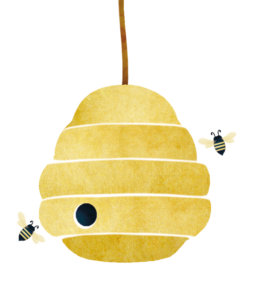By Barbara Woodward
There are many reasons to want an attractive yard or garden. To be the envy of the neighborhood or to win “yard of the month” are great reasons, but how about for the good of the planet we inhabit? I think that’s the noblest reason of all.
Our planet’s survival depends on a fragile balance between our eco-system and our selfish desires. We depend on pollinators – birds, bees and even bats – to help our food sources grow. Of all the pollinators, bees are top ranked for this purpose. So, why not do something for them in return?
Pollinator-friendly plantings
Bees rely on host plants for their habitat and nesting sites. Certain plants provide food, shelter and a place to raise their offspring. This is also true for butterflies and other pollinators. Here’s a small list of plants that provide for their survival.
Trees: Maples, boxelder, cherry, willow, basswood, buckeyes, redbud, sycamore, hazelnut, hickory, river birch, fringe tree and dogwood
Shrubs: Silky dogwood, pasture rose, raspberry, blackberry, blueberry, serviceberry, sweetshrub, oak-leaf hydrangea and false indigo
Flowering perennials: Milkweed, joe-pye weed, monarda, woodland sunflower, rose mallow, goldenrod, trumpet honeysuckle, coneflower, verbena, cardinal flower, nasturtiums, salvia and phlox
Most of the plant species mentioned are not ones you will find at large retail stores. They are found growing naturally, or are available at smaller nurseries and native plant sales put on by ecologically minded organizations.
If you require order in your garden, natives are not for you. Like nature itself, native plants are “messy.” This natural chaos is exactly what our pollinators need.
An example of natural chaos is observed in butterfly host plants. Caterpillars cannot travel long distances, so butterflies must lay their eggs on plants they can feed on to survive. Caterpillars eat the leaves and leave the host plant looking decimated. Most gardeners get upset by this natural phenomenon, but we must plant for the greater good.
 Pesticide-free garden
Pesticide-free garden
The second part of keeping a healthy garden for pollinators involves not using pesticides. Pesticides, fungicides and herbicides are all harmful – or even lethal – to bees and other pollinators. If you must use pesticides, the following can be used when bees are not active (in early morning and after dusk). Once dry or dissolved, these products aren’t harmful to bees: Spinosad, Pyrethrum, Neem Oil, boric acid, horticultural vinegar, copper and lime sulfur.
Other products that can be applied any time and won’t harm bees are sulfur, garlic, kaolin clay, corn gluten and gibberellic acid. Natural alternatives are bug traps (sticky tape), baited bags, beneficial insects and chickens or guineas.
Native plants are less susceptible to pests and therefore circumvent the need to use pesticides. This brings us “full circle” to why natives are best for our gardens and our planet. Bees pollinate our fruits and vegetables and produce honey – what a bonus. Butterflies and birds entertain us and incite us to slow down and enjoy nature’s pace. Realizing this planet belongs to all creatures big and small should encourage us to live in harmony with them and see after their survival.


